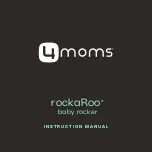
WWW.BALTIMOREAIRCOIL.COM
5
DANGER:
Rotating equipment
will cause severe personal injury
or death to persons who come in
contact. Do not perform any service,
maintenance or inspection on or
near the fans, motors, and drives,
or inside the unit without first
ensuring that the fan and pump
motors are disconnected, locked
out, and tagged out.
General
• If the unit is mounted on vibration isolators (by others), refer to the vibration isolation
manufacturer’s guidelines before loading/unloading weight from the unit.
• Verify the fan and the pump motors are disconnected, locked out, and tagged out.
Cleaning
• Drain the cold water basin with the strainer in place.
• Remove all dirt and debris from the fan guard(s) and combined inlet shields.
• Inspect and clean all spray nozzles.
• Clean all of the mechanical components, such as the fan and motor.
• Flush the cold water basin to remove any accumulated dirt and debris.
• Remove, clean, and replace the basin strainer.
Inspection
• Conduct external inspection of the equipment. Check for leaks, corrosion, and any
structural damage.
• Conduct internal inspection of the equipment. Check for anything unusual such as
structural or mechanical component damage.
• Inspect piping and connections.
• Thoroughly inspect the fan(s) for any mechanical or physical damage.
• At seasonal start-up or after prolonged shutdown, check the motor insulation with an
insulation tester prior to the motor start-up.
• Except for the PT2-0412, prior to seasonal start-up, check and adjust the belt
tension. Prior to the initial start-up, the belt tension may not require adjustment as the
drive will be properly tensioned at the factory prior to shipment. However, tension of
new belts must be adjusted after the first 24 hours of operation.
Start-Up
• Prior to seasonal start-up, lubricate the motor base adjusting screw, if applicable (see
page 14
) and the fan shaft bearings (see
page 15
). At initial start-up, no bearing
lubrication is required since the bearings are factory lubricated prior to shipment.
• Apply RUST VETO
®
to steel shafts, and bushings.
• Fill the cold water basin with fresh water to the overflow level via the make-up valve.
• Set the make-up valve float so the water shuts off at the operating level (see Table 1
on
page 10
).
• Start the system pump.
• Adjust the system flow rate to the design rate. Open the supply valve slowly until the
design flow is reached.
• Check that the float operated make-up valve is operating freely. Closely monitor the
water level and adjust as necessary during the first 24 hours of operation.
• Inspect the nozzles and heat transfer section as described in “Water Distribution and
Heat Transfer Section” on
page 16
.
• For multicell arrangements, balance flow between the cells to obtain even water
distribution.
Unit Operation and
Storage
Start-Up Procedure
Considerations for Initial
Start-Up
General
Cleaning
Inspection
Start-Up
NOTICE:
Spray system pressure
greater than 10.0 psig may cause
damage to the distribution system.








































